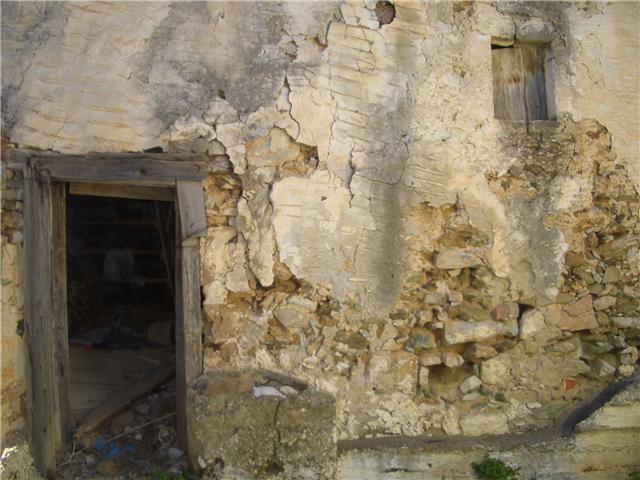'Do not ever let go of a dream. Do not let go of wanting this dream to become a reality.
If you ever, for reasons beyond your human control, lose this dream, I urge you to find another dream and another and another. Never stop dreaming, ever.'
This website is about a Dream shared by many, but not yet fully realised:
To restore the beautiful village of Achlada in Crete,
to provide appropriate care for the elderly residents and to
make the village a thriving artistic and historical centre.
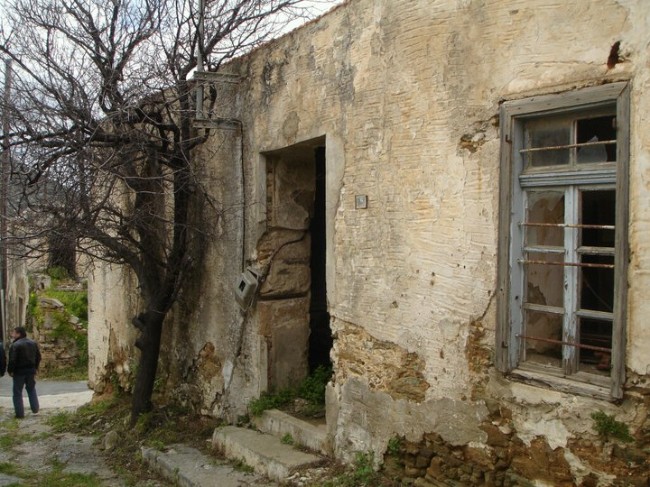
The old school waiting to be restored.
Above photographs by Gabi Witthaus April 2011
The old olive press building or 'Fabrica' waiting to be restored..... GS 2011
Update April 2011
I am very grateful to Yiannis Pediotis (Liontogiannis) a local resident and Ioanna Mathioudaki, who works in real estate for taking us around Achlada, in a cold April wind. Yiannis has an encyclopaedic knowledge of the history of Achlada and it was a real privilege to see his ancestral homes. We imagined him and his four brothers playing in the wild mountainside. It was also good to hear that Katerina Athanasaki from the Heracleion Museum is recording the history of the village and the area through oral history accounts such as the one we were so grateful to hear, first hand, from Yiannis. Mount Psiloritis in the distance bore witness to the unseasonally cold northern wind. It gleamed white covered in snow and ice and looked stoically on as we traversed the island in our hired car. Achlada looked magnificent in the sharp spring light. The excellent news is that thanks to the new Mayor of Agia Pegagia Mr. Mamoulakis, the old oil press or 'Fabrica' and the old school are going to be restored to their former glory.
After the Easter Mass in Heracleion where the resurrection was finally celebrated to the sound of deafening fireworks, we drove in the near pitch darkness to Achlada, arriving at three in the morning. Looking at the village from the church mount-the highest point in the village, the few lights in the darkness bore witness to the love that the few remaining residents have for this beautiful place. One day, it will be a thriving community once again, thanks to the spirit of the locals. As Greek people in the local area start to seek the illusive qualities which defined the lives of their parents and grandparents and take them back to their roots, Achlada will rise again and its heart will beat to the sound of the 'Christos Anesti' and the accompanying fireworks.
Update Summer 2010
This year saw us making a video of some of the buildings in Achlada and looking at the area around the church. The church is built on a hill at the edge of the village, on the main road on the way to the cemetery and the lovely Mourtzanakis Hotel, which descends into the hillside and discreetly sits in what must surely be, one of the prettiest parts of the island. I was welcomed by Mrs. Mourtzanakis, who, despite my unexpected visit, was very kind and allowed me a brief look into the hotel. This beautifully proportioned complex can be seen in more detail here http://www.ecotourismgreece.com
The purpose this year was to look more carefully at the idea of gradual radial expansion which was discussed earlier this year and can be seen later on this page. The large embankment on which the church is built was briefly examined for the possible construction of 'Stoes', these being small vaulted rooms built into the land mass. The purpose is two fold: to create a more aesthetic appearance to what is a large and plain concrete wall on three sides, and secondly, to offer room for a focal point in the reconstructed village.
On close examination, even before structural studies have been made, it seems possible to create three vaults which will be spaces dedicated to useful and relevant retail outlets: A traditional Bakaliko (general food shop) a Chemist and health food emporium specialising in traditional herbal medicine and encapsulating the knowledge and practices of local residents; and a small traditional furniture outlet, which will contain items for sale and samples to be made to order by traditional craftspeople from all over the island. A conscious decision to provide space for functional retailing was taken. No tourist shops are needed, rather places where good local produce and useful everyday items can be bought by the locals and visitors alike. A stoa in the process of being renovated is shown directly below. There is a space for a fourth vault, which could either be used as a small working oil press, or a studio for a working Lyra maker, or working Iconographer. The units will be rented at nominal cost, to be paid directly to the church, as and when we proceed with this development into the embankment. Photographs of the walls are shown below the vault image.
From the Summer 2010 sketchbook. A ten minute sketch of how it could so easily be transformed into one of the most beautiful villages on Crete.
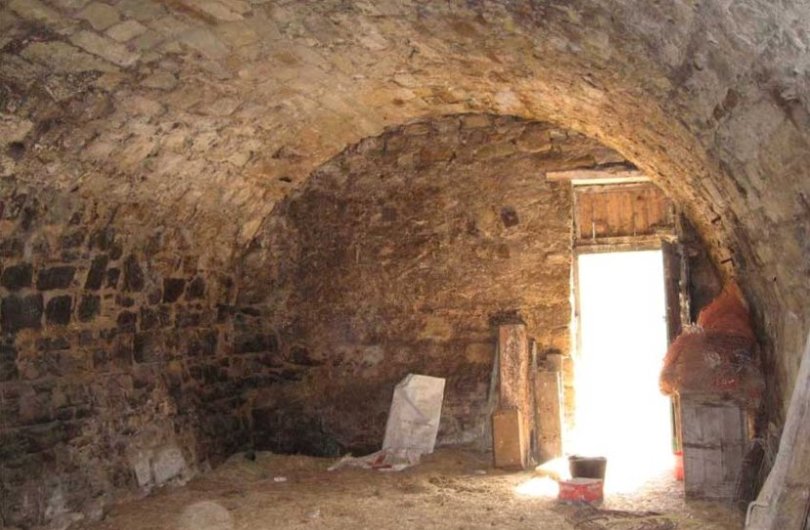
'Stoa', or Vault construction to be used in creating small useful and relevant retail space under the church.
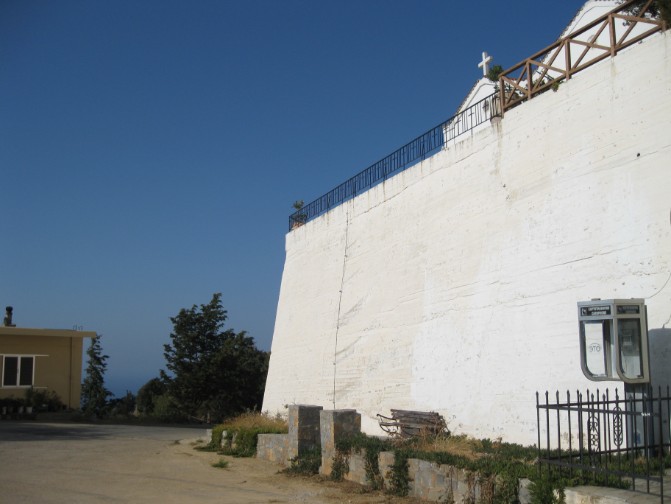
The large wall underneath the church (see above and below) was built as a solution to soil erosion, to contain the small hill on which the church rests. The proposal to create vaults in the surrounding wall will create a focal point and massively improve the poor aesthetic appearance of the concrete structures.
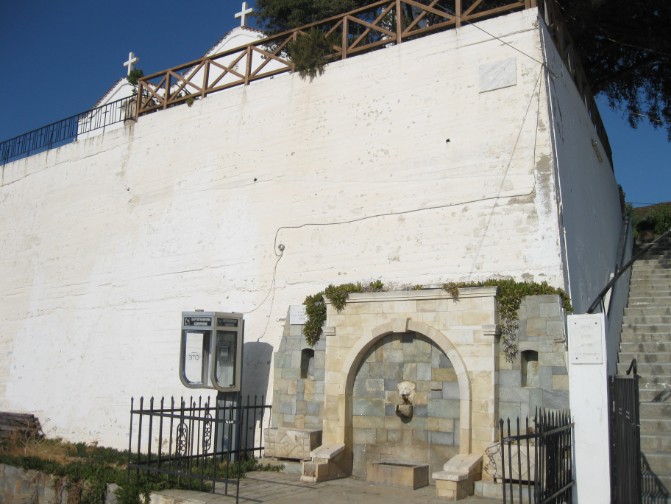
The Development of affordable housing.
I am currently in discussions with Pantelis Gallerakis regarding the construction of small affordable housing units built in the vicinity of the church, incorporating small gardens and aimed at attracting young couples and families into the village, offering traditional, affordable and ecologically sound accommodation, 30 minutes from Heracleion and 10 minutes from Agia Pelagia. Details and drawings to follow once land availability has been ascertained, and a topographical survey and deed search has been completed.
I am indebted to the writers of the following paper, which eloquently explains the general considerations, pertinent to our project. The full paper is available at :
lDENTlFYlNG ENDOGENOUS
RURAL DEVELOPMENT PARADIGMS
IN THE GREEK COUNTRYSlDE
Katharine HASSAPOYANNES,
University of Patras
lrene DASKALOPOULOU,
Natasa PETROU,
Mediterranean Agronomic lnstitute of Chania
(MAICh)
A holistic approach to current
impasses would require a balanced
interaction between internal and external
developmental forces in rural areas. This
way, co-ordinated actions between the State
and local agents could promote the gradual
integration of rural areas 'into the overall
economy of the country.
Measures for strengthening and establishing
endogenous development practices may
relate to:
Infrastructure, in order to improve
access to rural areas, and especially
to remote and less-favoured ones.
Rural desertification is partly the
outcome of low standards of living
stemming from a lack of infrastructure
(roads, telecommunications, health
and education services, etc.).
Moreover, infrastructure is an
essential requisite for access to
markets and for the successful
operation of any economic activity.
o Efficiency in the agricultural sector.
Specific programs providing individual
support measures for the practice of
agriculture in areas with unfavourable
structures (small average size of
farms, fragmented land, irrigation
problems etc,) raise farming costs and
weaken the competitiveness of
agricultural products. Apart from
structural adjustments, serious steps
should be taken towards the
establishment of joint farming groups
(with the collaboration of farmers),
and the achievement of economies of
scale.
Diversification of production systems.
For example, production should follow
the dictates of market forces while
creating the conditions for economic
viability with respect to the
environment. In accordance with
Community rules, organic farming
relates to various crop-farming
practices that protect the environment
and promote sustainable agricultural
development. It could be particularly
important for the sustainability of small
farms in those regions or areas where
major natural handicaps impair the
competitiveness of farming. These
areas include, for example,
mountainous areas, less-favoured
areas and Mediterranean areas where
the establishment of viable
conventional agriculture is hampered
by the lack of water, naturally poor
soil, and inefficient farming structures.
Economic efficiency of local markets,
in order to achieve greater and better
distribution of income in rural areas. In
any given area a network of cooperation
between local processors
and local consumers can be
established, in order to promote direct
consumption of local products by local
consumers. A food distribution circuit
could be seen as the result of the
extension of farming to the food chain.
In certain areas, this could imply the
establishment of a linkage between
farmers and local consumers. Such a
circuit could constitute a challenge to
the traditional notion of a 'chain' of
enterprises which represent
successive phases in the processing
of uniform products.
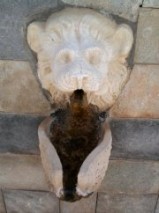
The water fountain at Achlada. GS 2010

UPDATE 22nd December 2009
The term was coined at a recent meeting, of interested parties, whereby an aerial photograph of the village of Achada was used to asess the extent of work, the starting point and the logistics of restoration and rebuilding in stages, over a period of 5 to 10 years.
The beginning is a critical time, as this will clearly signal the intent and extent of re-development, and will play an important role in attracting additional local interest and support.
The consensus is currently that development needs to take place 'radially' extending out from an agreed point of significance. In Achlada, the Church is in a prominent position and surrounded by buildings which are reasonable well maintained. This could be the centre of the radial development. A cursory look at the aerial photographs will show the directional 'push' of re-development.
On the map, the smaller red circles are the suggested sites for a Geriatric care base and a Visual/Applied Arts Centre.
This proposal needs local consent, investment and of course before all that, additional consultation, which will have to be led locally by the Cretan participants.
UPDATE 1st September 2009
I was really pleased to see the ACHLADA group formed on Facebook quite recently. It gives me hope that other people are seriously interested in reclaiming back from the clutches of time and decay, one of the most beautiful villages in Crete. It is a wonderful thing to see the power of words and of an idea. Please encourage people to join both groups- the 'The Sensitive Restoration of the Village of Achlada in Crete' which I launched earlier in the year and this new one, and spread the message.
The Sensitive Restoration of the Village of Achlada in Crete:(FACEBOOK GROUP) Established 16th August 2009).
I would like to invite all
interested parties living in Crete and abroad to join this project, if
they feel they can commit to a long term vision. Please also publicise
this initiative. I would in particular like support from experts in the
areas of Funding, Environmental concerns, Cretan History, Archaeology,
Rural Architecture, Sanitation, Demographic Change, Geriatric Care and
Outreach, Public Relations, Politics, Economic and Cultural
Regeneration, Linguistics, Iconography, and Traditional Cretan
Furniture making and design. Your involvement the first place will
be voluntary, but as I formulate the bid I will build in necessary
costs for consultation. Many grateful thanks, George Sfougaras |
UPDATE AUGUST 2009
I
have now met with Pantelis Galerakis, a major figure in construction and land sales in Crete, who expressed his interest in being
involved in the project. His company has the means to evaluate the
scale of the rebuild costs and the feasibility of restoration. It was
his knowledge of the local situation that was so helpful.
Panteris
Apostolis , Consultant at the Manucipality of Gazi and Dimitris Auroulakis, President of the Community of Achlada, met with me to discuss the idea, and
both expressed an interest in continuing with this. Both are
significant public figures in the life of the Prefecture of Gazi and
both live and work for the good of the community. I offered to return in
October, to present the idea to the regional council and to the
residents of Achlada and Agia Pelagia.
I met with Katerina Athanasaki, from the museum
services, and we spoke about the project. Her book on the island of
Crete, is the definitive archaeological work on the area. It is an
amazing work. I am very grateful for her ideas and her insights into
the area of Achlada and Agia Pelagia. I have scanned and included several pages.
Thank you to everyone for making me feel so welcomed.
Ming Lim, a consultant who has been working
with the leadership team on the remodelling of my school. I am not
sure of her availability and time, but I feel we need to utilise her broad knowledge of processes and initiatives
in the area of consultation redevelopment and bid formulation.
Ming has been asked to help write the bids for the earth-quake stricken
region in Italy. I will keep you informed.
Finally, I have taken
the liberty of meeting with Christianna Sfougara-Lapidi,
who works in the financial sector in Crete. I would like her to use
her knowledge, to help us find an appropriate and capable, independent
and highly impartial financial manager to oversee the funding as we
proceed. This will be a critical post, working alongside the project
co-ordinator, who will have the overall vision and drive to manage the
various complex parts of the operation and ensure that they remain
transparent to all concerned.
Thank you
Yiorgos Sfougaras
Please contact me on reclaimingthedream@hotmail.com, or leave a note on the 'Leave a Message' page.
